
Stones with a name: the gravestone collection
Hebrew inscriptions are a visible element of a world now disappeared, populated with people that are no longer there and of whom only the names remain. Jordi Casanovas, a well-remembered expert on Hebrew inscriptions, believed that stones are a catalytic element of memory and, although lacking in explicitness, they actually tell us many things. As the prophet Habakkuk (7th century BC) said: "For the stone shall cry out of the wall, and the beam out of the timber shall answer it."
The tombstones from the Jewish cemetery bear the names of women and men who formed part of the Girona Jewish community between the 12th and 15th centuries. Reading these names, in conjunction with Irene Llop's research into documents in the city archives, has meant that we now know details of the life stories of those that were buried in Montju´c. The stones serve as a memory for Dolša, of the Ravaia family; Salomˇ Cabrit, from an old family of doctors; Estellina, who owned silver jewellery and one of the fortunes of the Jewish quarter; Salomˇ, the son of Rabbi Jucef ben Teca, who died at the age of twenty-two; Jucef, the charming child whose premature death must have broken his parents' hearts; Caravida, a wealthy influential man who may have been a doctor or perhaps a merchant. The epitaphs mention prominent lineages: Aninai, Astruc, Cabrit, Caravida, Des Mercadal, Ravaia, Salem and Saporta. Through the names of the people from the Jewish quarter, these stones preserve the Jewish memory of Girona as a precious treasure.
The complete collection is made up of 29 tombstones or fragments with Hebrew inscriptions as epitaphs. Not all tombstones are presented in this resource, as we have focused our research on those bearing a name: this is the thread that has allowed us to get to some details of the lives of the people to whom the tombstones were dedicated.
Dolša (... Abraba)lia. First half of the 14th century
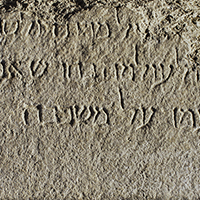
"Mrs." Dolša had a very common name among medieval Catalan Jews. She was married or widowed, although we cannot be sure that Abrabalia was the name of her husband. If the hypothesis is correct, she belonged to the Ravaias (Abrabalia in Hebrew), the most prominent of all Girona Jewish families. This very powerful family settled in Catalonia in the 13th century from Castille. Among the women of the Ravaia family, there was also a Bonafilla, daughter of N'Astruc Ravaia, who in 1283 exercised as a moneylender without the need, it would seem, for a male to support her in the profession.
Wife or daughter of Salomˇ Cabrit. 14th-15th centuries
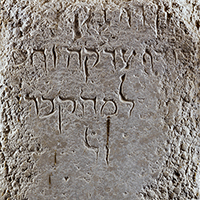
Salomˇ Cabrit may have been the Perpignan Jew who owned possessions in Girona documented at the end of the 14th century, but we do not have any biographical information about his wife or daughter. Salomˇ, who died in 1395, was the son of MossÚ Cabrit, a Banyoles Jew, and had at least two brothers: Abraham Cabrit (Girona Jew as of 1375, died in 1391, the family member we have most documentation for, especially regarding moneylending; we know that he and his descendants lived in the Girona Jewish quarter) and Asmies Cabrit (married to Tolrana, of the Perpignan Jews). In 1372, Salomˇ Cabrit gave to his brother Abraham all the rights he might have on the house that had belonged to their late father. The house was located in the Girona Jewish quarter, within the block of houses in the disappeared street that reached as far as the present small square Institut Vell, according to a document from 1296 that mentions the house of MossÚ Cabrit.
Estellina, daughter of Astruc Cohen. 1411
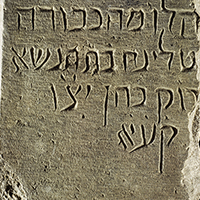
Estellina was the daughter of Astruc Cohen. The fact of her father and not a husband being named suggests that the girl died young. The father was called nasi (prince), the title given to prominent men in the Jewish community. Indeed, he was one of the most influential people in the Jewish quarter between 1386 and 1415. According to the list of aljama's councillors in the ordinances of 1386 and 1391, Astruc Cohen served as an assistant the third year, and was among the new councillors in the reforms of 1391. Prior to that date, his name can be found among the taxpayers of the aljama in Hebrew documentation, and he was also a moneylender. Following the riots of 1391, he was among those imprisoned in Torre Gironella. At the beginning of the 15th century, the queen appointed twelve councillors to settle a payment owed to the heirs of the knight Joan Janer, including Astruc Cohen (year 1408), although he was not required at the following year's summons. The last news of Estellina's father dates back to 1415. That year, book inventories were made in order to seize copies of the Talmud and Astruc appears as a councillor at the presentation of the inventories. Therefore, Estellina formed part of Girona's Jewish elite, and may have experienced the 1391 riots and subsequent decline of the Jewish community. After her death and in a context of decline, the family continued with Judaism.
Meirona, married. First quarter of the 15th century
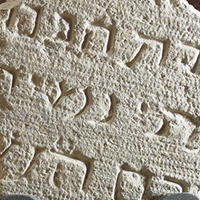
Meirona was a very common diminutive among medieval Catalan Jewish women, but there are not sufficient data on the tombstone to identify her.
Astruga?, wife of MossÚ Astruc. First quarter of the 15th century
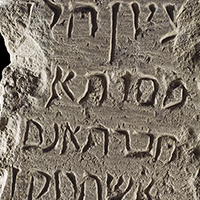
Only the initial of the name is preserved, which could be Astruga, since she was the wife of MossÚ Astruc. Shortly before the riots of 1391, he appeared as one of the new leaders of the aljama. After the attack, MossÚ Astruc was among those imprisoned in Torre Gironella, and continued in Judaism. His name is on the list of those who submitted book inventories in 1415, and we know the number of volumes that he had at that time: thirty-two books (only five people had a higher number of volumes). MossÚ Astruc had a sister, Ester, who became Christian and took the name of Joana, marrying Pere Joan, a convert (previously MossÚ Cabrit, son and heir of Abraham Cabrit, who was the brother of Salomˇ Cabrit). On August 9, 1395, Joana, Pere and Puigvert d'Agramunt sold an allodial house in the Jewish quarter to MossÚ Astruc and his wife Dolša. And in 1417 said couple sold a house in the Jewish quarter to Pere de BerguedÓ, provost of the Pia Almoina of the Cathedral. In documents from 1415 and 1416, there is also mention of a courtyard that MossÚ Astruc sold to the aljama. This tombstone raises many questions, since the women's name that appears on it does not coincide with the documentation from the archives.
Regina, widow of Salomˇ Salem. Towards the middle of the 15th century
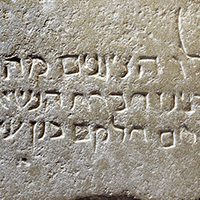
No data has been found for Regina. We know that she was a widow because the epitaph says "Take their places in the Garden of Eden", referring to both members of a couple. Although the name Salem does not appear in the Girona documentation, Salom is present: Salomˇ Salom was a Jew from the second half of the 14th century, prior to 1391; his name appears in a paper notebook that recorded payments made for the tax called ajuda.
Estellina, widow of Bonastruc Jucef. Towards the middle of the 15th century
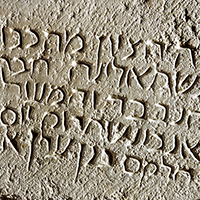
Estellina is the only recorded woman mentioned alone in the documentation. We do not have data for her family of birth, but she married an important Girona Jew, Bonastruc Jucef. Her husband played an important role in organizing the aljama at the beginning of the 15th century, by designation of the queen, and was also a major moneylender. In 1412, Estellina's husband held a convert girl called Elionor against her will, although we do not know why. In the payment of the taille tax in 1426, Bonastruc Jucef contributed 30 sous and 6 diners (5.5% of the total collected). This was a very significant amount, and only five families paid more. Following the death of Bonastruc Jucef, Benvenist Samuel was the executor of his will and administrator of his fortune. Probably the former's son-in-law, Benvenist Samuel appeared in Girona from 1434 until 1462, and acted as overlord in the community. Of the thirty contributors from the Girona aljama in the collection of the one hundred sous taille tax of the year 1450, the biggest payer was Benvenist Samuel (with 78 diners, 6.5% of the total) and the first woman (the fourth highest contributor) was his mother-in-law Estellina, widow of Bonastruc Jucef (with 66 diners, 5.5% of all taxes paid). Shortly afterwards, in the year 1458, the inventory of cutler Pere Riera, who lived in Ballesteries Street, reveals that N'Estellina, a Jew, had a silver strap with a gold-headed buckle, with fourteen gold-plated panels, a silver bracelet and two spoons, also silver. Although we cannot be sure it is the same person, it is likely.
Salomˇ, son of Jucef ben Teca. 1198
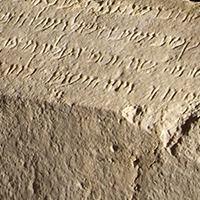
This is the oldest and only tombstone in the entire collection that states the age of the deceased: twenty-two. He was the clever, charming and select Salomˇ, son of Jucef ben Teca. Unfortunately, we do not know his biography. His epitaph begins with "I will weep tears in mourning and eulogies for his mother and brothers", which could indicate that these were his closest relatives and his father had already died and he had not yet formed a family of his own.
Issac. 1210
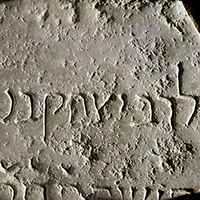
Issac was one of the most common names among medieval Jews: in the 13th century, fifty-seven Jewish men have been documented with that name in Girona alone.
Salomˇ, son of JafudÓ Des Mer(...?). 1289
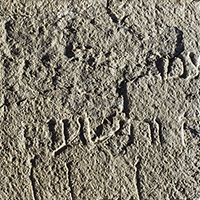
It has not been possible to identify this person since Salomˇ was a common name and the name of his father was not preserved in full. However, it would appear that it might be the Des Mercadell family, which is well documented in Girona throughout the 14th century.
Hanoc, son of Saltell Saporta. 1312
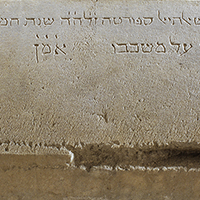
It has not been possible to find documentation regarding this person. In Girona at the beginning of the 14th century there is documentation for a Hanoc from Castellˇ, a Hanoc Condom and a Hanoc Cundranya, but no Hanoc Saporta. The father of the deceased passed on a very old Girona surname, Saporta, which had different variants (Porta, Saporta, ša Porta). Several men from the lineage acted as secretaries and prominent men in the aljama, but if there was one outstanding member of the family, it was Bonastruc ša Porta, MossÚ ben Nahman, the most important 13th-century authority on the Talmud. Furthermore, in 1305, a Barcelona Jew named Saltell de Porta, son of Vidal de Porta, sold an annual census on a piece of land located on the mountain of Girona to two Christians.
Jucef, son of Baruc Abrabalia. 1324
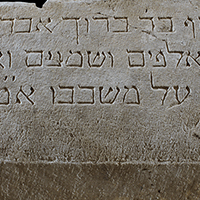
Neither the son nor the father have been documented. The name Abravalia is the Hebrew form of Ravalla, Ravaia or Ravaya. This family from Castille settled in Girona and Castellˇ d'Emp˙ries before spreading to several Catalan towns. They managed to attain great power not only in the Girona community, but also in the royal court. The most notable members attained a great deal of power in the 13th century: Astruc Ravaia was appointed bailiff of Girona, and was exempt from taxes; his son Jucef was a royal bailiff in Besal˙ and in Girona, administrator of the royal patrimony, royal adviser and first royal treasurer; his brother MossÚ was general bailiff of Catalonia, tax collector and seller of royal income. In the 14th century, several members of the Ravaia family were recorded in relation to the houses they owned in the Girona Jewish quarter. Abraham Ravaia had a house on Forša Street, and the city councillors (known as jurats) bought him stone to use on the walls. Astruc Caravida bought Issac Ravaia's houses (with rights to light, carriage, water and a patio); his widow gave them to their daughters, Bonafilla and Ester, who sold them to Bonastruc Vidal. Shortly afterwards, the city's jurats made them tear the houses down.
Jessua, son of SÚsset. First half of the 14th century
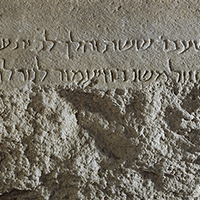
Although SÚsset is a common name among the Jewish people of Girona, no documentation has been found in Girona for any Jessua, son of SÚsset, or Yehoshua ben Sheshet.
Jucef, son of Jacob. Second half of the 14th century
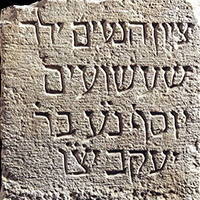
One of the most common names among the medieval Jewish people of Girona, Jucef must only have been a child at the time of his death. The epitaph makes this clear with the words "delightful boy". We have no other reference to his family than the name of his father, Rabbi Jacob, who has not been identified in the documentation from the archives.
En Caravida. 14th-15th centuries
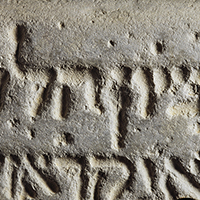
The first person of this name in Girona is documented in a loan in 1227. The first name Astruc is present in members of this family in at least four consecutive generations, and was probably reserved for the first-born son. At the end of the 13th century, the Caravida were also in Besal˙, Manresa, Vilafranca and Vic. In Girona, one of the most prominent figures of this family was Astruc Caravida, father of Ester, who was involved in a very conflictive divorce in the middle of the 14th century (married to David Bonjorn de Barri, of Cotlliure, she only obtained a divorce from her husband after stealing his books and scientific instruments in 1337; Jacob ben David Bonjorn, author of the famous astronomical tables, was the son of Ester and grandson of Astruc Caravida). In 1347, Astruc's will initiated a charitable legacy for the alms of the Jewish quarter (heqdesh). After his death, the family began a period of decline, and never regained the prestige and power of the previous era. Some family members, such as Salomˇ Caravida, were doctors, and others were involved in running the community, acting as secretaries of the aljama. Caravida has also been recorded as a first name: Caravida Ravaia, Caravida Saporta, Caravida Caracosa, all members of important families in Girona Jewish society, and very possibly children of women from the Caravida family.
Ardut. Second half of the 14th century
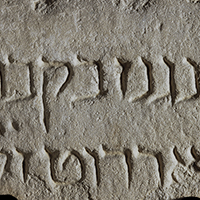
This small fragment of the tombstone does not allow the person to be identified. The name Ardut is not mentioned in Girona, either in Hebrew or Latin documents. However, in Huesca (Aragon), there was a whole family of doctors called Avinardut, or Ibn Ardut, between the 14th and 15th centuries.
David, son of Jucef. 15th century
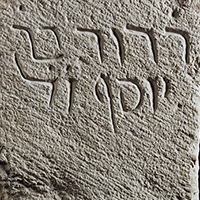
We do not have sufficient data to identify David Jucef, or David son of Jucef, for such a broad period as the whole of the 15th century.
RovŔn, son of Haninai. 1343
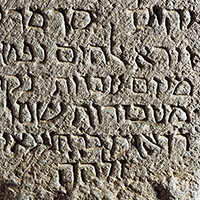
This is the only tombstone in the Museum from Castellˇ d'Emp˙ries; unfortunately the deceased could not be identified. Haninai may correspond to the name Aninai/Aninay/Avinai, a family of great importance in Girona in the 15th century. This family probably had branches in nearby populations and within its area of influence.
© 2026 Patronat Call de Girona | Contact | Accessibility
